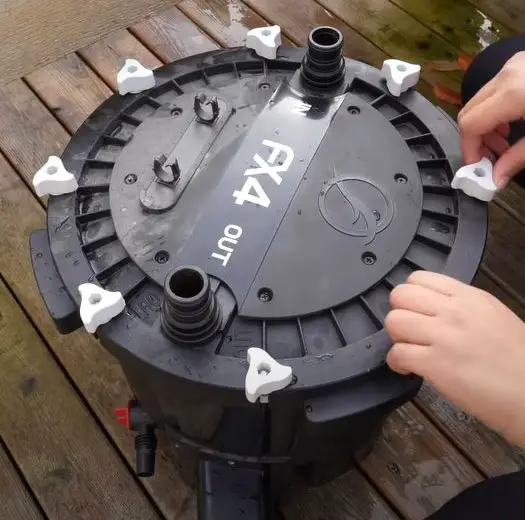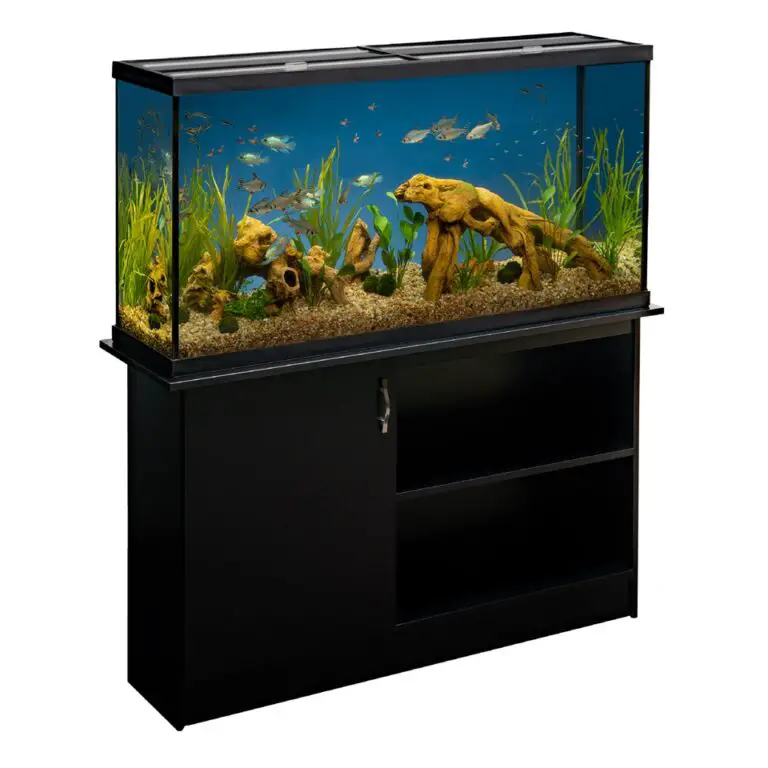Tiny White Bugs in Aquarium
Tiny white bugs in an aquarium are most likely one of two pests: either an infestation of microscopic planaria or a colony of miniature fish lice. Planaria look like small pieces of thread and can reproduce quickly if left untreated. Fish lice appear as tiny, whitish spots on the sides and fins of fish, but can be hard to see without close inspection.
The best way to treat both is with a commercial medication specifically designed for the type of pest you have in your tank. It’s also important to make sure that the water conditions are correct by testing pH levels and making sure no ammonia is present before introducing medications into your tank.
Having tiny white bugs in your aquarium can be a frustrating problem, but it’s important to take the necessary steps to get rid of them and prevent future infestations. These tiny white bugs may be either fungus gnats or cyclops copepods, both of which are common aquatic pests. In either case, it’s important to act quickly and use an appropriate treatment solution to eliminate the current population while also preventing further reproduction.
Once you’ve identified the pest and treated your aquarium accordingly, keep up with regular maintenance tasks like water changes and filter cleaning to ensure that these unwanted visitors don’t return again.
Tiny White Things on Aquarium Glass
Tiny white things on aquarium glass are usually caused by diatoms. Diatoms are single-celled algae that use the nutrients in the water to photosynthesize and grow, forming a slimy film of silica deposits on surfaces such as rocks, substrate, and glass. Although harmless to fish and other aquatic life, diatoms can be unsightly if left unchecked.
Fortunately there are several ways to remove them from your tank including scrubbing with an algae magnet or using chemical treatments specifically designed for this purpose.
Tiny White Bugs in Aquarium Gravel
Tiny white bugs in your aquarium gravel are most likely common planaria, a small flatworm. Planaria are harmless and actually beneficial to the aquatic environment as they feed on decaying organic matter that would otherwise rot and release toxins into the water. While these tiny worms can be unsightly, they won’t cause any harm to your fish or other inhabitants of the tank.
Water Mites in Fish Tank
Water mites are small arachnids that can find their way into aquariums and fish tanks. They feed off of algae, decaying matter, and even the blood of some fish. Water mites can reproduce rapidly in a tank or pond environment and may cause health problems for your fish if they become too numerous.
To help prevent water mites from invading your tank, it is important to keep up with regular maintenance such as changing the water regularly and removing any debris that could be providing food for them.
How to Get Rid of Tiny White Bugs in Aquarium
One of the most common problems for aquarium owners is dealing with tiny white bugs. These pests, also known as “white spot disease,” can cause a variety of issues in an aquarium, from discoloration to death of fish. The good news is that there are several ways to get rid of these pesky critters.
To start off, it’s important to remove all infested plants and decorations; then use a water treatment such as Aquari-Sol or Rid-Ich Plus which contains malachite green and formaldehyde to kill the bugs. Once this has been done, it’s best practice to quarantine any new fish introduced into the tank before adding them back into the main aquarium. Additionally, regular maintenance like cleaning out debris and changing water regularly also helps keep these annoying invaders away!
Tiny Bugs in Freshwater Aquarium
Freshwater aquariums are home to a wide variety of tiny bugs, including copepods and micro-arthropods. These small organisms play an important role in the health of the tank by consuming uneaten food, helping to break down waste materials, and providing nutrients for larger inhabitants. Regularly cleaning your tank can help keep these populations healthy and reduce their numbers if they become too numerous.
Tiny Bugs in Aquarium Gravel
Aquarium gravel is often home to tiny bugs, such as nematodes and copepods. These organisms are beneficial for the aquarium’s ecosystem; they help break down organic matter, provide food for bottom-dwelling fish, and add oxygen to the water. While these bugs may be small in size, they can play a big role in keeping your tank healthy!
Copepods in Freshwater Aquarium
Copepods are small crustaceans that make excellent inhabitants for freshwater aquariums. They help keep the tank clean by eating algae, uneaten fish food, and other organic waste materials. Copepods also provide a source of live food for many species of fish and invertebrates.
Since they reproduce rapidly, they can quickly establish themselves in an aquarium’s ecosystem, providing a natural balance to the environment.
Tiny Black Bugs in Fish Tank
Tiny black bugs in a fish tank are likely copepods, small crustaceans that live in aquatic habitats. Copepods feed on leftover food particles and wastes from other aquarium inhabitants, so it’s important to provide regular water changes and adequate filtration for your fish tank to keep their populations under control. If you notice a large number of these tiny creatures swarming around the surface or bottom of your aquarium, consider adding some plants or rocks that they can hide among as well as removing any extra debris with a net.

Credit: www.reddit.com
Are Water Mites Harmful to Fish?
Water mites are small arthropods that live in fresh and saltwater habitats. They are not typically harmful to fish, but they can become a nuisance when present in large numbers or if the fish is already stressed from other sources. Water mites feed on algae, bacteria and other organic matter found near the surface of water bodies, so they are important members of aquatic ecosystems.
However, their presence can also cause irritation to some fish species due to their spiny legs which can cause physical damage while they crawl over the body of a fish. Generally speaking though, water mites pose no threat to healthy aquarium specimens as long as infestations remain under control – this means regular cleaning of tanks and filters and monitoring for signs of stress or disease in your finned friends.
Are Copepods Harmful to Fish?
Copepods are small crustaceans that inhabit both freshwater and saltwater ecosystems. They are an important part of the aquatic food chain, providing a source of nutrition for fish, other invertebrates, and even some bird species. Unfortunately, copepods can also be harmful to fish in certain situations.
In high concentrations they may consume so much plankton that it deprives other organisms of their food supply or competes with them for oxygen in the water column. Overpopulation can also lead to increased stress on fish due to overcrowding and competition for resources such as shelter and food. Additionally, certain types of parasitic copepod larvae may attach themselves to a host’s gills or skin causing physical damage or systemic infections which can be fatal if left untreated.
It is therefore important that aquarists monitor their tank’s population levels carefully in order to avoid potential problems associated with overstocking or harboring parasites within the aquarium environment.
How Do Copepods Get in My Tank?
Copepods are small, shrimp-like crustaceans found in the ocean and many freshwater habitats. They are an important part of the aquatic food web, providing a critical source of nutrition for fish and other organisms. But how do copepods get into our aquariums?
There are several ways that copepods can find their way into your tank. The most common is through live rock or substrate added to the tank during setup. Copepods can also be introduced by adding certain types of macroalgae such as Caulerpa species or Chaetomorpha linum, which often harbor large numbers of these tiny creatures.
Finally, you can buy cultures of copepods online from specialty suppliers, although this method requires some knowledge and experience with culturing live organisms in order to keep them alive in captivity. Once established in your tank’s environment, copepods will reproduce rapidly and provide a sustainable source of food for any inhabitants!
What are Very Tiny White Bugs?
Very tiny white bugs, also known as psocids or booklice, are small insects that feed on mold and fungi. They range in size from 1mm to 5mm in length and are usually cream-colored. Psocids can be found all over the world and thrive in damp, dark places such as bathrooms, kitchens, basements, attics and behind walls.
These bugs often enter homes through open windows or cracks around doors. Although they do not bite or cause any harm to humans directly, they can be annoying when they appear in large numbers indoors. To control an infestation of very tiny white bugs you should first identify where they are entering your house from and fix those entry points if possible.
You should then clean away any signs of moisture (such as wet clothing) that could attract them inside the home. Finally using a vacuum cleaner will help get rid of any existing pests before using insecticides to prevent further invasions.
Au-fwuchs! – What Are Those Little White “Bugs” in My Fish Tank?! Those Aquarium Specks on the Glass
Conclusion
In conclusion, tiny white bugs in an aquarium can be difficult to identify and treat. However, by properly cleaning the tank and researching any potential treatments for the bug species that is present, you should be able to get rid of them without too much difficulty. Additionally, if you take preventive measures such as regularly changing your tank water and maintaining good hygiene practices in its maintenance, you will likely prevent any future infestations from occurring.






